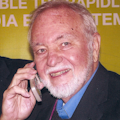Envelope Tracking Now Essential to Achieve PA Linearity and Efficiency
One of the most popular topics at the recent International Microwave Symposium (IEEE MTT-S) was envelope tracking (ET). Many power amplifier (PA) manufacturers and some of the test equipment makers showed demos of this linearization technique. While Doherty amplifiers and digital pre-distortion (DPD) techniques have proven successful in some equipment, envelope tracking (ET) has become the must-have technology in high power microwave transmitters for basestations and other applications.
Wideband modulation techniques like OFDM require highly linear PAs to faithfully pass all the spectral components representing the data transmitted. Linear amplifiers are the least efficient of all PAs. Most operate class AB for the best possible mix of efficiency and linearity. However, OFDM is one of those modulation schemes that has a high peak to average ratio meaning big swings in the amplitude of the modulating signal. Since linear class AB PAs have the least efficiency at low amplitude levels, power dissipation can lead to significant disadvantages, especially for battery powered handsets.
What ET does is dynamically modulate the PA DC power supply. The modulating signal is used to vary the PA supply voltage to keep it at a level that provides the best efficiency. This point is where the amplifier is at or near compression. Best efficiency occurs when the peak signal levels are near the DC supply level. The result is that the overall efficiency is increased from an average of 25% to over 60%. This has the overall effect of greatly decreasing the power dissipation and the attendant heat. An increase in battery life is another positive outcome.
One of the leading developers of the ET method is Nujira of the UK. Their work started with the high power RF amplifiers but now extends to single chip PAs for LTE smartphones. These phones typically use GaAs PAs with an output capability in the 27-29 dBm (500 mW) range. They provide the linearity needed by the LTE 4G radios but eat battery power and get hot. Nujira recently introduced their NCT-L1300 modulator chip for use in mobile handsets. It can swing the DC supply over the 0.5 to 4.5 volt range delivering best possible efficiency and linearity. ET is ideal for handsets as no complex, power hungry DSP is needed as with DPD.
I spoke recently with Nujira’s Jeremy Hendy (VP Sales & Marketing) who also indicated that the new chip demonstrated an adjacent channel leakage ratio (ACLR) of -53 dBc. That kind of performance is essential to minimize adjacent channel interference in the LTE spectrum where other services are present. Jeremy also indicated that the chip could be optimized for either best efficiency or best linearity conditions that do not occur at the same supply voltage. This adjustment is done in a lookup table that drives the DAC in the LTE modem chip that, in turn, drives the ET modulator chip. A quick switch of the software lets the designer select the best performance for the situation.
If you are not yet familiar with the ET method it is time to learn it. It has become an essential technology along with DPD for best efficiency and linearity in RF PAs. www.nujira.com
About the Author

Lou Frenzel Blog
Communications Technology
Click here to find more of Lou's articles on Electronic Design.